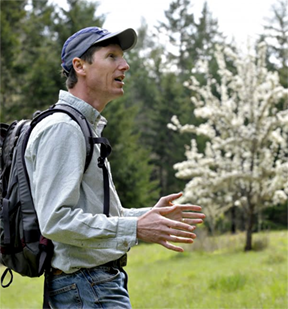Garden news

- Fall planting gives trees a head start
- From Seed to Shining Seed: How restoring diversity will save us all
Fall planting gives trees a head start
From the Fall 2022 Treekeepers newsletter

Spring may get us fired up about digging in the soil, but fall is a better time to plant trees here in Oregon. Generally, mid-September through mid-November is the sweet spot. The soil tends to be warm and that allows the plants a long time to get established and develop strong roots. And once the rains return, you won’t have to water them as much as spring-planted trees. Here are some steps to help those trees get a good start.
Do some research before choosing your tree to make sure your tree will thrive in the sun exposure and soil conditions. Group plants with similar water needs. “Right plant for the right place.”
When choosing where to place your tree, think long term. Space them for their mature size. Before digging, be sure to call 811 to check with utilities. If you have an in-ground irrigation system, be sure to locate pipes.
Prepare the soil well in advance. Clear away annual weeds and control perennial weeds like bindweed by digging them out by the root. Pre-watering will make it easier to remove them if the soil is dry.
Add compost and dig it in as deeply as you can. Adding three to four inches of compost six to eight inches deep is good if you are digging by hand. If the soil is bone dry, be sure to pre-water it before adding the compost. Soak the soil, wait a couple of days, and dig the compost in. You want wet roots to go into wet soil, so if the soil is still dry, fill the planting hole with water, let it drain, fill it again and plant while the water is still there.
Check whether the tree you have purchased has become rootbound from sitting in a pot all season. If it is, tease out the roots or score the root ball to allow the roots to spread out into the soil. It’s a good idea to wet the roots by placing the tree in a large bucket with water and waiting until it quits bubbling.
After planting, water immediately and thoroughly. Then apply a good donut of wood chip mulch around the trunk of the tree to keep weeds down and conserve soil moisture. Keep the mulch six inches from the trunk to allow it to breathe. Don’t forget to remove any tags from trees. As your tree grows it may grow right around the tag, strangling the limb.
Water every week—or twice a week if it’s hot—until the rains start. After that, your tree should be on its way. Now sit back and enjoy imagining the mature tree that will flourish there!
This helpful article is from the latest Treekeepers of Washington County newsletter.
From Seed to Shining Seed: How restoring diversity will save us all
Tuesday, October 4, 7-8 pm, via Zoom. Free, register here.

Join the Washington County Master Gardener Association for this presentation on the importance of ecological diversity that is at the core of a resilient Earth. Featured speaker is Dr. Tom Kaye, PhD, Executive Director, Institute for Applied Ecology, and Assistant Professor in the Dept. of Botany and Plant Pathology, Oregon State University.
Dr. Kaye will discuss the importance of biological diversity for the ecosystem and human health; how we measure and restore diversity on the landscape; the ways in which biodiversity improves ecological functions, and more. For more information and to register, please click here.
Dr. Tom Kaye is founder and Executive Director of the Institute for Applied Ecology (IAE), a nonprofit organization with a mission to conserve native habitats and species through research, restoration, and education. He is also a courtesy Associate Professor in the Department of Botany and Plant Pathology at Oregon State University. Tom conducts research on rare species reintroductions, habitat restoration, plant invasions, and plant population responses to climate change, and engages prison inmates in conservation through the Sagebrush in Prisons Project. Sourcing native plants for restoration is a key area of interest, research and publication for Dr. Kaye. He serves as a Commission Member on the IUCN SSC Seed Conservation Specialist Group.





